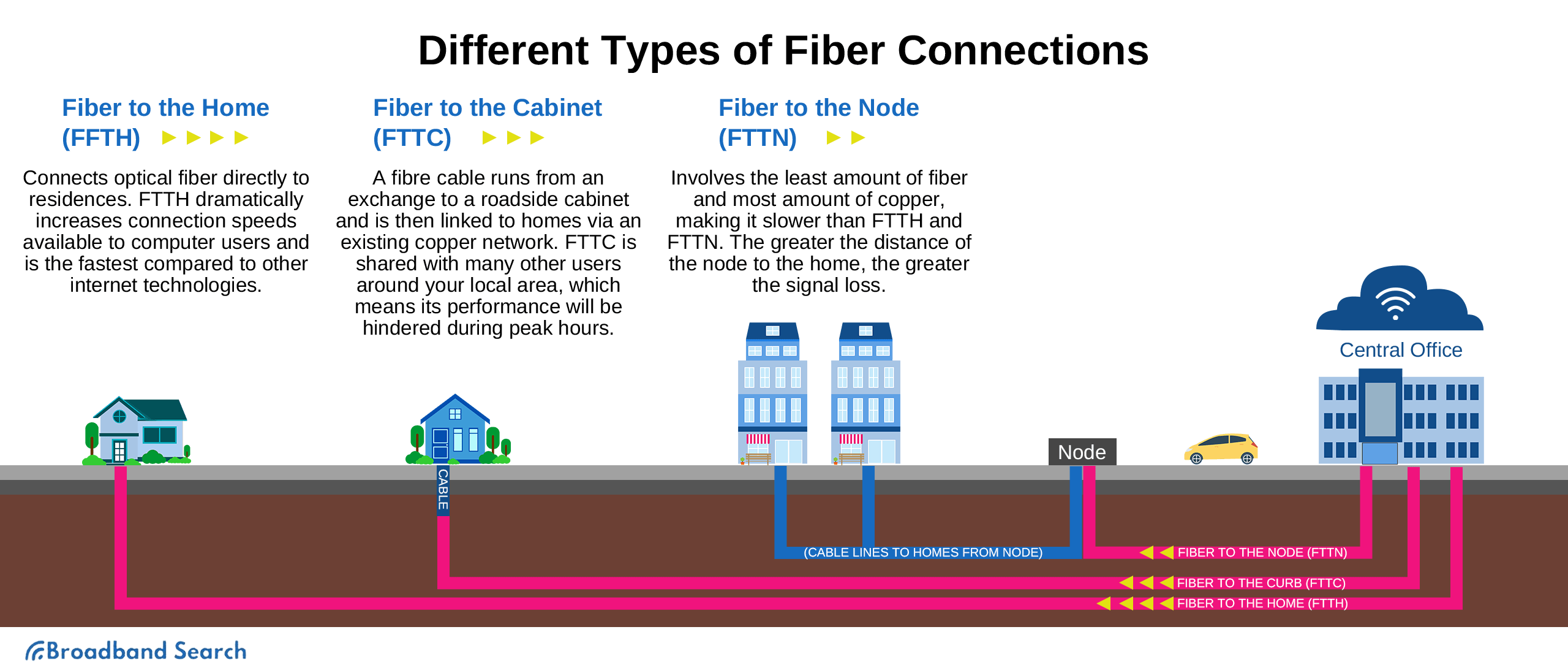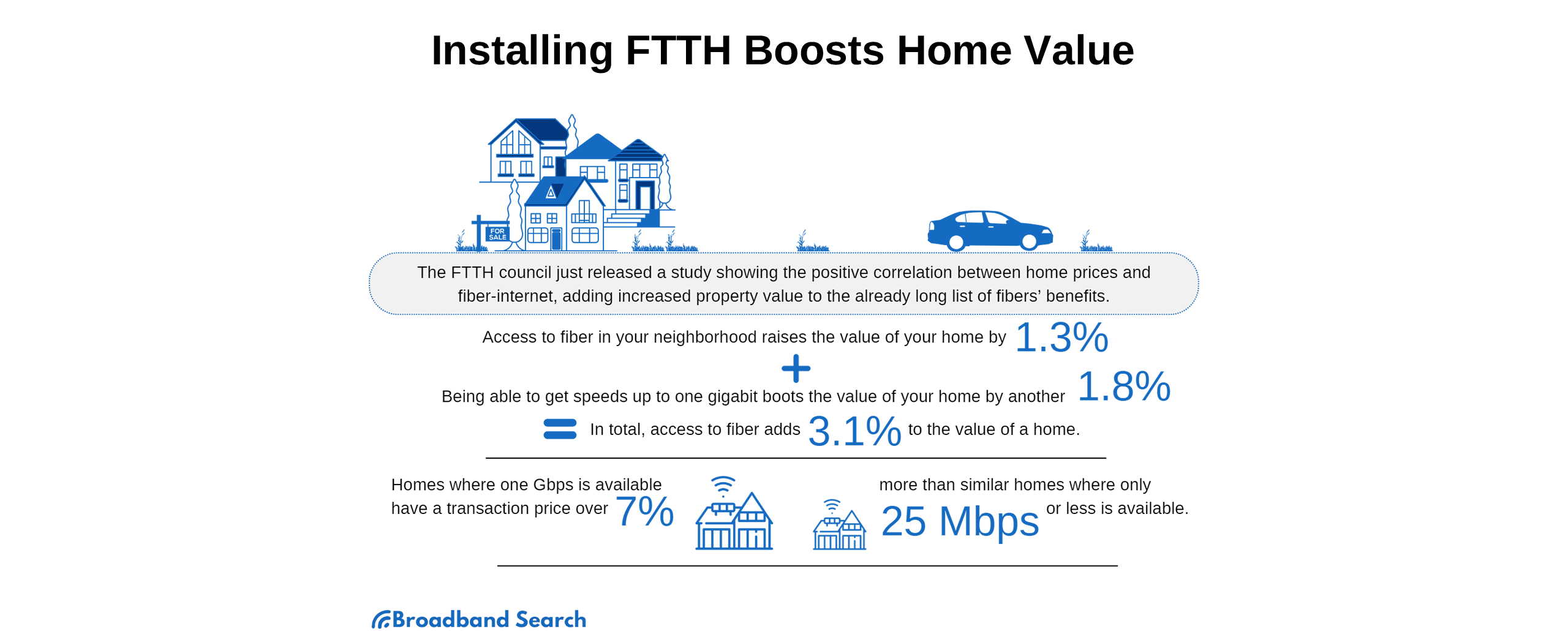You’ve probably heard about fiber internet, but did you know that you can get several different types of fiber? FTTH is one of these types of fiber and is gaining popularity because it’s considered the best and fastest option for home broadband and businesses. So, what exactly is FTTH? And what are the other types of fiber optic internet available to us? Read on to find out!
What is Fiber to the Home (FTTH)?
All types of fiber are called fiber to the “X” (FTTX) - the X representing a particular object. For example, FTTX for Fiber to the Home becomes FTTH, where the H is “Home.” To explain FTTH simply, this type of fiber has a fiber line that runs from a central point directly to your home. This is different from other types of fiber that may only have fiber lines that run up to a certain point (such as a node or cabinet), which may cause you to get slower than expected speeds. Since the fast fiber optic cables run to your home, it allows you to get the best possible connection, which is why it’s considered the best option.

FTTH vs. Other FTTX Connections
Fiber to the X connections function similarly but differ in how they connect to the end user. We’ve already gone over the way that FTTH connects to the end user, so now we’ll take a look at a couple of the other FTTX connections:
FTTC (Fiber to the Cabinet)
FTTC - or Fiber to the Cabinet - doesn’t have fiber cables connected directly to houses. Instead, it has fiber cables connected to a cabinet either in the street or near a home or business. Then, a twisted pair connection (i.e., a copper cable) transfers the signal from the cabinet into the end user’s home.
The great thing about FTTC connections is that they’re highly available. This means it can be fast to set it up because the infrastructure is already in place. The downsides, on the other hand, are that the connection might be contended because it usually has other people sharing the same connection. As a result, it ends up being much slower than FTTH connections.
FTTN (Fiber to the Node)
Fiber to the Node is a setup that delivers fiber to the closest node to your premises. Just like FTTC connections, FTTN connections transfer the signal to copper wires, which then run to your home. FTTN connections usually don’t take the fiber cable as close to your home as FTTC connections, meaning FTTN connections are slower.
The positive side of FTTN connections is that they’re cheaper and faster to install than other options. Unfortunately, the tradeoff is that these connections are slower and, therefore, may not be able to give you the internet experience that you need.
Why is FTTH the Fastest?
The thing that makes FTTH so fast is the fact that it doesn’t need to transfer the signal from a fiber cable to a copper cable (other than an extremely short connection that’s in your home itself). It also doesn’t need to take the signal a somewhat long distance through that copper cable to your home. Fiber cables can carry much more data faster than copper cables because they use light to send that data. And, since these fiber cables are connected directly to your home, nothing is reducing that speed.
Other Reasons to Choose FTTH
Other than its lightning-fast speeds, there are many other reasons why you should use FTTH instead of other FTTX connections. FTTH is becoming more popular. As of 2020, there are 50.6 million households with FTTH internet deployed in their homes. What makes it desirable?
Durable and Secure
Fiber cables are much more durable than other cables used for internet connection. This is because glass (which the cables are made of) does not conduct electricity, and the cables are also placed underground where the weather can’t destroy them as easily. Fiber cables are also a lot stronger than traditional copper cables, meaning they can withstand more in general.
Increased Reliability
Fiber internet isn’t just faster. It’s a lot more reliable too. So, if you’re using an FTTH connection, there is less chance of your signal dropping because there is less influence from other types of connections and copper lines.
FTTH is Future Proof
FTTH is considered “future proof” because it’s easier to upgrade the infrastructure around this type of fiber connection without updating the fiber in each house. Since the fiber runs all the way through to the houses (and this technology is likely to be used for a long time), companies can make upgrades that positively impact the end user without needing to replace any copper lines with fiber lines.

Conclusion
And that’s why Fiber to the Home is such a great choice when setting up your home fiber internet connection. It’s not only faster but also a more reliable option - especially regarding the future of internet infrastructure. Just keep in mind that it is harder to find than many other types of fiber internet, so you may need to settle for one of the other FTTX options that are out there. That said, if you can get FTTH in your home, you should go ahead and do it.
FAQ
Which router is best for FTTH?
There are a lot of routers out there, each one catering to different needs of the individual user. If you’re looking for the best router for FTTH, you’ll first need to look at things like cost, the internet speed of the plan you want, reliability, and much more. Considering all of these things will help you to identify a fiber router that best suits your needs and makes sense for your household.
What internet is better than fiber?
Depending on how you look at it, there is no better internet than fiber. Fiber internet is the fastest internet connection, most reliable, and has the most potential for the future. The main downside is that it isn’t always easily accessible because infrastructure is still being built. But in our eyes (and in most people’s eyes), fiber is the best type of internet around.
Why is fiber faster than Ethernet?
Ethernet cables use electricity to transfer data, while fiber cables use light. Since light travels at a much faster speed than electricity, fiber cables can provide you with much better internet speeds than what you can get through ethernet cables.
Is 5G better than FTTH?
The benefit of 5G technology is that it is wireless and can still provide you with extremely fast speeds (even when you’re moving around). However, if it’s speed in particular that you’re looking at, FTTH connections still come out on top. In addition, fiber connections aren’t impacted by weather as easily as wireless connections, so FTTH is also more reliable.
How to install fiber to the home?
You will need a professional to do most of the FTTH installation process. The professional will need to lay the fiber line to your home and connect that line within your home to your ONT and modem. Only after this can you do the rest of the installation yourself if you want to (and if your ISP allows it). To do this, you will first need to contact an ISP and purchase a plan. After this, you will need to set up your router by connecting it to the modem and going through the various setup steps that your ISP requires. Once that is done, you’ll be able to activate your line and should be able to start using the internet.

